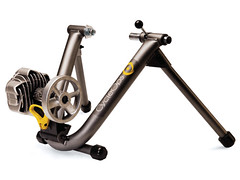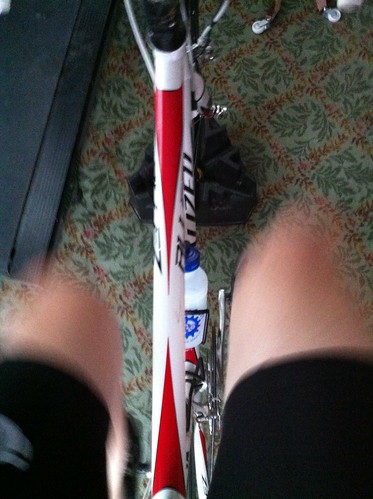Note: this post is part two of
a three part series. If you like what you've read, consider contributing to a fundraiser
called the Tour de Cure. If this helps you or someone you love, please
consider clicking here to see more donate to support my campaign on behalf of the American Diabetes Association. Thank you!
In the
first part of my "Hack Your Metabolism" series, I talked about
eating and how to pay attention to what you eat and what that does to
your blood glucose (BG). I made the case that even if you weren't
watching your blood glucose due to risks associated with diabetes, it is
worthwhile to pay attention to it anyway. Why? because it helps you to
monitor the amount of energy you take on board. Too much energy coming
in means that the body has to deal with a "rich mix" in the bloodstream:
high blood glucose. Over time if this rich mix condition persists,
metabolic changes start to happen. One that concerns most people is that
you accumulate fat. Why? Because that is one way the body stores excess
fuel it hasn't an immediate need for.
What Exercise is NOT For
This second installment of "Hack Your Metabolism" isn't precisely
about fat, though. I bring up the subject because I want to address a
misconception that many people have about the role of exercise in
staying healthy, losing weight, and controlling BG. That misconception is
that exercise is for using up the energy you took on board from eating a
recent meal. Like earlier that day. Or even earlier that week. You hear
this kind of thing all the time: "I have to work out later because I
ate like a pig yesterday!" Or this: "I ran today, so I'm going to treat
myself to a Triple Venti Frappucino with Whip..."
Yeah, no. That's not what exercise is for.
For one thing, it is difficult for most people to exercise long enough
and with enough intensity necessary to make up for any "extra" eating
they do measured in calories alone.
That Frappucino? 510 calories. I'd have to run more than
20 miles at 10 min/mile pace to burn that many calories! But recall our
little discussion about
mindful eating. Did we talk about calories
there? No. We talked about carb units. That little post-workout treat
at Starbucks would be worth almost six of them (84g). And a big spike in your BG levels
to go with it. Even if you worked out really hard and for a really long
time -
with a few little exceptions limited to the first 30-45 minutes after exercise - your body reacts the
same way to that big cup o' carbs no matter what!
So What *is* Exercise For?
Adaptive stress.
Engaging in exercise presents a challenge to your metabolism causing
adaptation. Ideally. Where there is no challenge, there is no change.
This idea is consistent with our discussion of mindful eating. Recall
that the body is amazing at mobilizing regulatory systems to achieve and
maintain a sense of "business as usual." You might recall the
scientific name for this:
homeostasis. New stress on the system -
whether it comes from lifting weights, pedaling a bicycle, or doing yoga
- may present new energy needs to muscle groups as they are challenged.
The body responds to these challenges not only in the short term
(burning calories during a workout), but also by preparing for the next
similar challenge. These longer-term changes are signaled and initiated
during exercise, but take place long after the workout is done while the
body is recovering from the effort.
So the point of a workout is the change that results when your body is
at rest afterward. This includes an array of changes to your metabolic
systems that regulate energy, its storage and its use. Your body is
constantly adapting to the conditions it finds itself in, in fact,
whether you are working out or not. It is always trying to achieve
homeostasis. This is a moving target. When you are more sedentary, for
instance, the body adapts to that too. Adaptations to chronic high BG, a
condition that can happen when your intake of carbs keeps that "rich
mix" flowing, put stress on the mechanisms associated with insulin
response. The body usually adapts to these stresses in ways that
maintain homeostasis, until it cannot anymore. This is a condition
related to Type II diabetes (T2DM), but it is life-threatening on its
own even when some of the T2DM symptoms are in check. It goes by another
name: Syndrome X or Metaboblic Syndrome.
I wrote about that in a post titled Rx:Bike. Some of the thoughts in that piece helped shape this
one. Check it out. And then go ride a bike. But first, I have just a few
more things to say about exercise and adaptive stress.
What Kinds of Exercise Produce Good Metabolic Changes?
I have great news in response to the question that I get asked a lot:
"what kind of exercise should I do?" Answer: any kind! All kinds!
Whatever feels fun to you. Whatever makes you smile and lifts your mood.
Me, I like bikes the best. And running, well, it's complicated. But I
do it. I've learned to like yoga. I hate push ups, but I like the core
workout stuff ok. I love to play sports like basketball, softball. I
even juggle. It's all good. No really.
It
*is* all good because, depending on my fitness level and the kind of
activity I choose, it can all apply a "dose" of adaptive stress that
will produce positive metabolic changes (among others). The more
sedentary you are, the more likely it is that any amount or any level of
physical activity will kick off some positive adaptations. As you get
more fit - that is, as your body re-models itself internally and
externally to better handle the heightened needs for energy, strength,
and endurance that your new activity level requires - the "dose" of
adaptive stress will have to change in order to produce positive
results. So you run a bit longer or a bit faster, lift a heavier weight,
or maybe add some Zumba classes to your your twice-a-week water
aerobics schedule.
It's all good. Potentially. But it is not all good for the same thing.
Different kinds of workouts produce different kinds of changes, of
course. But let's keep things simple and talk just about varying two
factors of exercise that apply to almost every activity you can think
of: duration or length of the workout and intensity or how much effort
the workout requires.
Two Categories of Adaptations that Enhance Metabolism (And How to Cause Them)
As with my advice in Part I, the information I am presenting here is a
mix of things that are well known if not always well followed and
relatively new knowledge produced, in some cases, by some recent
science. Some of it is quite surprising. I won't explain all of that
here. But if you want a very engaging overview, check out
The Truth About Exercise with Michael Mosely.
What I will do instead is break down two kinds of changes to metabolism
that seem to be related to different kinds of exercise. This, in turn,
may help you exercise a bit more mindfully.
1. How to Enhance Your Insulin Response to Regulate BG More Efficiently
This one is easy and fast, if not painless: short, maximum-intensity
intervals of exercise. This is sometimes called HIIT, or high intensity
interval training. An interval is a timed unit. And an intense interval,
in this case, means that you should be working at your full potential
for a very short burst of time. A work interval is done at max effort
for 15, 20, maybe eventually 30 seconds at a time. This is followed by a
recovery interval that is at least as long if not longer. Just a few of
those intervals - 3 or 4 to start and then maybe 5 or 6 later on -
twice a week is all most of us need to see a measurable improvement in
insulin response. The reason is not quite yet well known, but it is
thought to be related to building and strengthening the neural pathways
associated with insulin signaling. This effects the way the body
uses insulin, and so this adaptation is not tied exclusively (or perhaps very strongly at all) to the way the body
makes
insulin (
the science here is early days, but really interesting). So even if you get your insulin from somewhere other than your
body, these kinds of exercises may help. And for those whose bodies
make insulin, including those with T2DM, HIIT works.
As with all exercise, the adaptations we see from HIIT will begin to
fade if the length and intensity of "the dose" is too consistent. So as
you get more fit, you might throw some intervals into the middle of
another, longer workout rather than just doing three 15 second bursts.
Or you might vary the length, or the recovery period between. But the
essential idea - quick, high energy bursts - remains the same.
How you achieve these matters very little in terms of the end result at
the metabolic level, except that you have to put your whole body to work
including your cardiovascular system. And so how you do them *does*
matter in the real, macro world of your whole body and your life.
Running is one way to do HIIT. But running even in short bursts at
maximum effort is hard or impossible for some folks. It is a little
easier on a hill. But with running, the biomechanics of the activity put
limits on getting to that "maximum effort" level. I find it hard to do
with swimming too, because my stroke is so sloppy I simply can't keep a
short intense interval going (maybe I should swim with sharks?). I think
a bike - and especially a stationary bike - is best for these
exercises. A regular bike works too, though you need a spot where you
can go all out with little risk. Up a hill is good for this because all
out doesn't necessarily mean high speed. Weight lifting usually doesn't
do it, but "circuit training" routines where you quickly move from one
exercise to another with no breaks can certainly get you there.
2. How to Get Your Body Using Stored Energy from Fat All Day, Every Day
Do long, steady, exercise that builds lean muscle and endurance. The
opposite of HIIT in many ways, exercise that gets your body in a rhythm
of converting glycogen stored in the liver to blood glucose and
converting fat into glycogen to replenish those stores is slow, steady,
and long. Like walking. More walking, more often, will apply a kind of
stress that asks your body to use its energy system in a consistent way.
I think of it as calibrating the "thermostat." Instead of lighting a
fire to heat the house and then putting it out or opening the window
when it gets too hot, we set a thermostat to cycle the furnace or boiler
on in our house to keep the temperature steady and comfortable.
To work well - by which I mean to produce the effective adaptation -
this type of exercise should not be too intense. Why? because that
shifts the body to a different energy use method. Intense exercise
produces a different, though no less desirable adaptation that we talked
about above with HIIT.
For athletes and others training for reasons related to performance -
i.e. racing or other forms of competition - it can be a tremendous
challenge to slow down enough to let this kind of adaptation happen. It
is also challenging for normal people like you and me for a different
reason: time. Slow is slow. And if we only have so much time to spend
working out, then we tend to want to "get the most out of it" and so we
amp up the intensity. And that can be beneficial. But that might not be
all we need.
The secret to doing this kind of exercise, then, is not to think about
it as exercise at all. But rather to make small adjustments in everyday
life to increase the amount (time spent) doing low-intensity activity.
Instead of parking close to the mall entrance, park far away and walk.
Take the stairs instead of the elevator. Get a
fitbit or another
pedometer and count your steps. Have standing meetings or walking
meetings when you can. Walk to work. Ride your bike to pick up a few groceries at the store.
Putting It All Together: Applying the Minimal Effective Dose
I know not everyone enjoys exercising. I happen to. I like to find where
my limits are and see if I can extend them. But testing your limits in a
race or a crazy-long endurance event like a marathon is not necessary
in order to hack your metabolism and get healthier. All you need to do
at any given moment is apply the minimal, effective dose of adaptive
stress. (I know
this guy uses that term, and on this he's right.)
Exercise smarter, and yes sometimes that means *harder* and sometimes it
means *longer*, but it doesn't mean go out and run a marathon or, maybe not even a mile. It means do
what will challenge your body to adapt, today, in the way that will
produce a better "normal" state tomorrow. That might mean doubling your
steps per day and doing two HIIT sessions a week several days apart. It
might mean a two hour walk on Sunday and run around the yard with the
dog on Tuesday and Friday. You get the idea. What it means for you will
change as your body changes. You'll be able to do more, do it faster,
and do it for a longer time. As you change, your minimal effective dose
will change. But if you apply it consistently, you'll not only change.
You'll get better.
Like what you read? Feel free to share, make comments or ask questions below. Also check out my Tour de Cure fundraiser here and consider a donation! Thanks!











